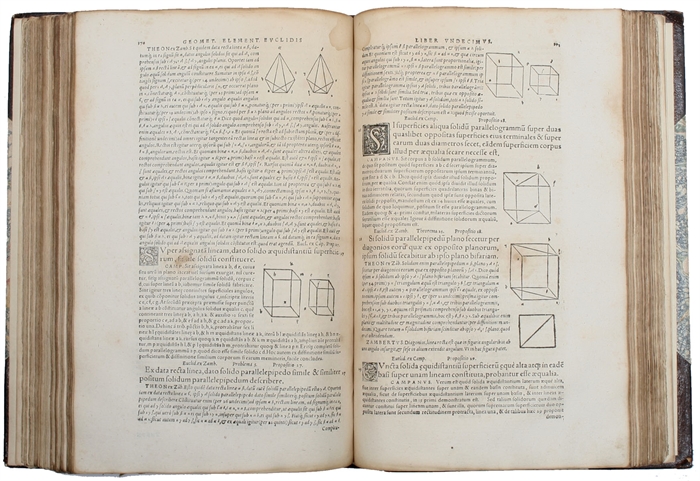EUCLID (EUKLID) OF ALEXANDRIA.
Euclidis Megarensis mathematici clarissimi Elementorum geometricorum libri XV. Cum expositione Theonis in priores XIII à Bartholomæo Zamberto Veneto (= Zamberti) latinitate donata, Campani in omnes, & Hypsiclis Alexandrini in duos postremos. His addiecta Phænomena, Catoptrica & Optica, deinde Protheoria Marini, & Data. Postremum uero, Opusculum de Leui & Ponderoso, hactenus non uisum, eiusdem autoris. Cum priuilegio Cæsareo.
Basel, Johannem Hervagium & Bernhardum Brand, 1558. Folio. (30,5x21,5). Bound in 19th century brown hmorocco with 5 raised bands. Light wear to back and corners a bit bumped. (2),587 pp.Numerous wood-cut diagrams and initials throughout. First ab. 20 leaves with different degrees of yellowing and occasional with marginal faint dampstaining. 3 leaves with upper right corners repaired without loss of text. The "privilege" at verso of title partly unreadable as a piece of paper is pasted on, some of these letters are faint, just as some letters in "Basiliae" on title are weak. Last leaf with colophon and printers large woodcut-device on verso is mounted, but not hiding the wood-cut. The word "Basiliae" on last leaf recto, is weak or nearly gone. Overall a large good copy as usually without the foreword by Melanchton. A small rubber-stamp on title: "Duplum Bibliothecæ V.E." and in old hand: "Bibliothecæ Conventij Romani S. Andrea de Fratrij (?)"
Scarce third printing of the so-called Zambert-Campanus Edition of the Elements, all printed by Johann Herwagen in Basel - this edition printed together with his son-in-law Bernhard Brand. The first of the Herwagen prints was the famous Editio Princeps in Greek from 1533, and in 1537 he published a Latin version, which became the first Euclid-editon to contain also Euclids smaller tracts as "Phenomena"(Spherical geometry), "Katroptik" (Mirror-reflexion), "Optik" und "Data"(Geometrical excersises). The 1537- edition was reprinted 1546 and in 1558 (the present).
"The most famous source of Greek geometry is the monumental work of Euclid of Alexandria, called the "Elements" (around 300 B.C.). No other book of science had a comparable influence on the intellectual development of mankind. It was a treatise of geometry in thirteen books which included all the fundamental results of scientific geometry up to his time. Euclid did not claim for himself any particular discovery, he was merely a compiler. Yet, in view of the systematic arrangement of the subject matter and the exact logical procedure followed, we cannot doubt that he himself provided a large body of specific formulations and specific auxiliary theorems in his deductions. It is no longer possible to pass judgement on the authorship of much of this material; his book was meant as a textbook of geometry which paid attention to the material, while questions of priority did not enter the discussion." (Cornelius Lanzos in "Space through the Ages").
Max Steck III:57 - Thomas-Stanford: 15 - Riccardi 1558/3 - Adams E:976.
Order-nr.: 32859


